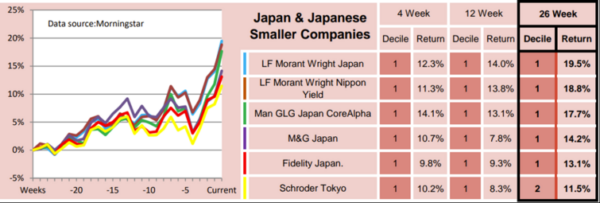Sep
2023
This fund region is in a rich vein of form
DIY Investor
30 September 2023
Saltydog Investor’s latest review of performance data shows there’s a fund region topping the charts over the past four, 12 and 26 weeks.
Last week, when we reviewed our fund performance data up to 16 September, we noticed how some of the funds from the Japanese sector had taken off in recent weeks.
Here is an excerpt from last week’s reports showing the leading funds from the Japan and Japanese Smaller Companies sectors, based on their performance over the previous 26 weeks.

I have checked again this morning, and the top three funds so far this month are all from the Japan sector.
LF Morant Wright Japan is at the top, followed by Man GLG Japan CoreAlpha, and then LF Morant Wright Nippon Yield. Out of the top 20 funds, ranked by their month-to-date returns, 13 are from either the Japan or the Japanese Smaller Companies sector.
Although Japan is the world’s third-largest economy, behind the US and China, it is unusual to see the funds that invest in it making their way to the top of our tables.
Japan’s stock market rose sharply in the 1980s powered by a strong export-driven economy. The Nikkei 225 went from around 6,500 at the beginning of the decade to an all-time high of nearly 39,000 at the end of 1989.
During that period there was also a real estate boom that eventually collapsed in the early 1990s. The bursting of the asset price bubble led to a prolonged period of economic stagnation, known as the “Lost Decade”. Japan’s stock market experienced a sharp decline, with the Nikkei 225 losing over half its value from its peak in 1989.
Japan’s economy gradually recovered during the early 2000s, driven by exports and increased business efficiency. However, like many other countries, it was caught up in the global financial crisis in 2008, which led to a brief economic downturn.
In 2012, Shinzo Abe became prime minister and implemented a set of economic policies known as Abenomics. These policies aimed to combat deflation, stimulate economic growth, and weaken the yen to boost exports.
The stock market initially responded positively to Abenomics, and the economy showed signs of improvement. From the start of 2012 to the end of 2019, the Nikkei 225 went up from around 8,500 to over 23,000, a rise of more than 175%.
Then the Covid-19 pandemic had a significant impact on Japan’s economy, leading to a recession in 2020. From then on it started to recover. The Nikkei 225 briefly went above 30,000 at the end of 2021, before dropping back down to around 26,000 at the end of last year.
Abe was replaced by Yoshihide Suga in 2020, who resigned a year later following criticism of his handling of the Covid-19 pandemic. Fumio Kishida took over in October 2021. All three are from the Liberal Democratic party, but Prime Minister Kishida is looking to move away from the Abenomics policies, which he said were not enough to create a sustainable and inclusive economy.
So far this year, the Nikkei has gone up by 25% and in June went back above 33,000 for the first time since 1990. It dropped below 31,500 in August, but subsequently recovered. The largest gains were in May, when it went up by 7%, and June, when it rose by 7.5%.
At the moment I am not sure exactly what has driven the funds investing in Japan up so steeply in the past few weeks, but they are certainly worth keeping an eye on.
For more information about Saltydog, or to take the two-month free trial, go to www.saltydoginvestor.com.
Alternative investments Commentary » Alternative investments Latest » Commentary » Latest » Mutual funds Commentary » Mutual funds Latest
Leave a Reply
You must be logged in to post a comment.